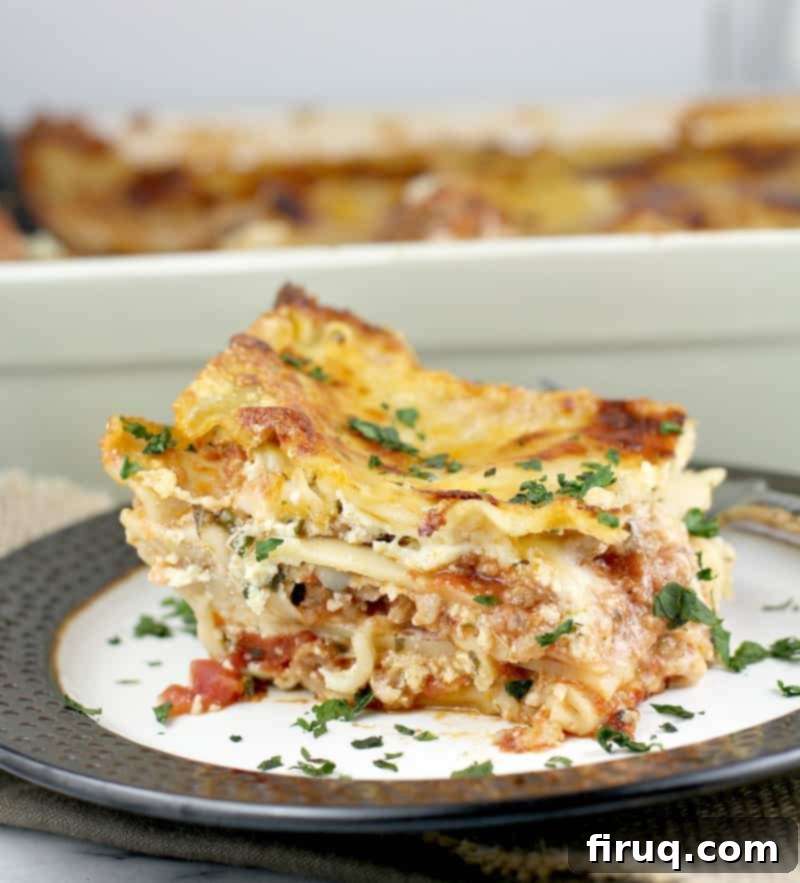Mastering Classic Lasagna: Your Ultimate Guide to an Unforgettable Homemade Recipe
There are few dishes that evoke the same warmth, comfort, and sheer culinary delight as a perfectly crafted lasagna. This classic lasagna recipe, with its savory sausage, rich homemade marinara, creamy ricotta and herb sauce, perfectly cooked noodles, and an abundance of melted, cheesy goodness, is designed to be the best you’ll ever make. We’ve meticulously gathered a wealth of insider tips and tricks to ensure that every layer contributes to an unparalleled flavor and texture experience, transforming this traditional Italian-American comfort food into a masterpiece right in your own kitchen.
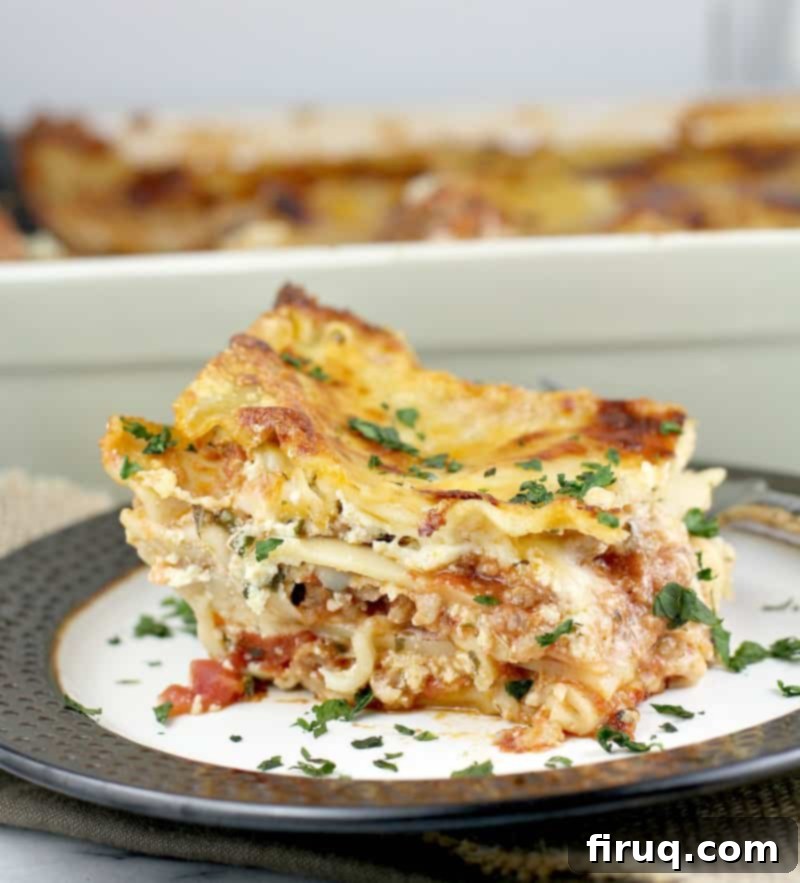
This post was first published April 2013 then updated January 2020 for photos and content. We continue to refine and share this beloved recipe for the best possible results.
What Defines Classic Lasagna? An American Culinary Staple
At its core, lasagna (or “lasagne” when referring to multiple pasta sheets, though often used interchangeably for the dish itself) is a symphony of layered pasta sheets, robust meat sauce, and various cheeses, often incorporating a creamy element like ricotta or béchamel. However, the term “classic lasagna” can vary significantly depending on where you are. In Italy, the dish typically features fresh pasta, often without the ruffled edges we associate with store-bought dried lasagna noodles, and commonly uses a béchamel (a basic white sauce) rather than ricotta. The very word “lasagna” in Italy can even refer to the specific type of cookware used to bake it.
Here in the United States, our beloved “classic lasagna” has taken on its own distinct identity. The addition of ricotta cheese, often blended with eggs and herbs, is a hallmark of the Americanized version. So, when we talk about a classic lasagna recipe, we are celebrating this deeply ingrained American tradition. This isn’t an attempt to recreate a Roman trattoria dish; instead, it’s a dedication to the rich, comforting, and utterly delicious lasagna that has graced countless family tables across the U.S. It’s truly the best homemade lasagna you will ever savor.
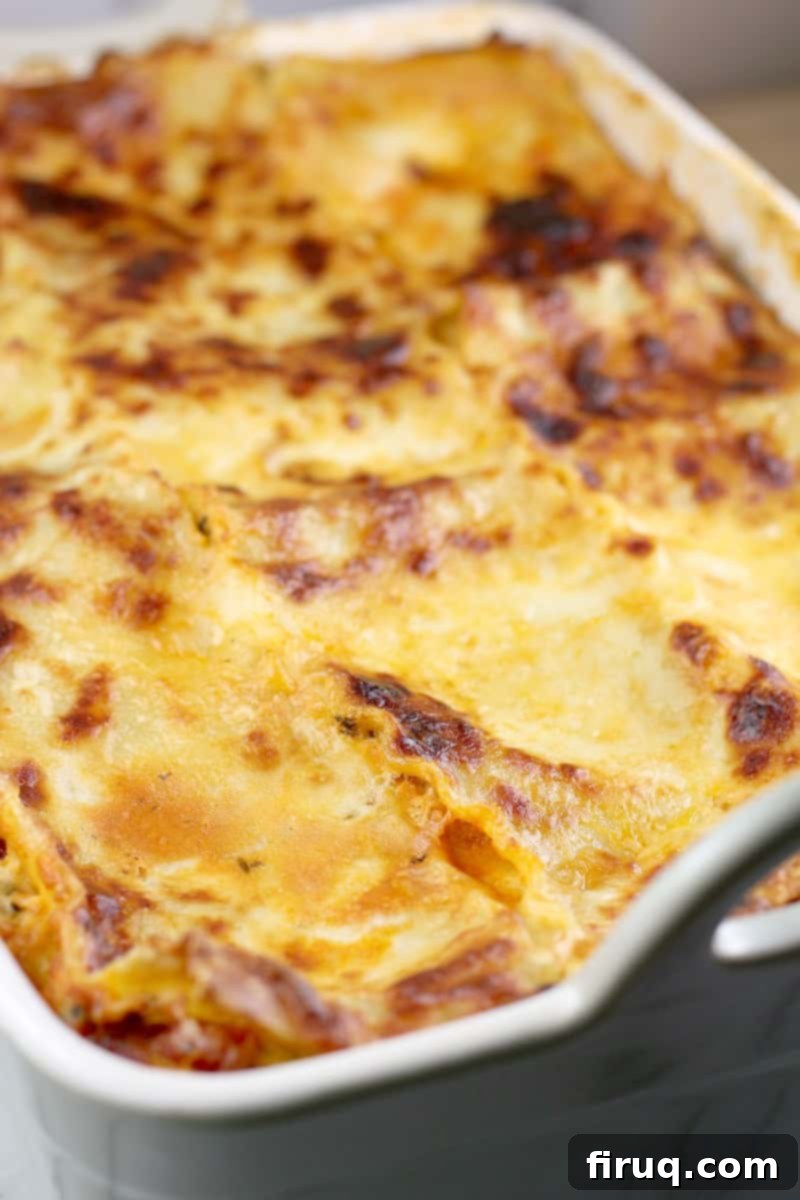
Our goal here is authenticity to this particular style – the traditional, hearty, and undeniably satisfying American classic. You won’t find us venturing into vegetarian adaptations, chicken or spinach additions, or replacing pasta with eggplant or zucchini. There’s no shrimp, no ground turkey, and no deviations from the core, time-honored ingredients. This recipe is a steadfast homage to the tried and true: a delicious, comforting homemade lasagna that brings back memories and creates new ones. Because when it comes to ultimate comfort food, few dishes compare to a good old-fashioned, perfectly executed classic lasagna.
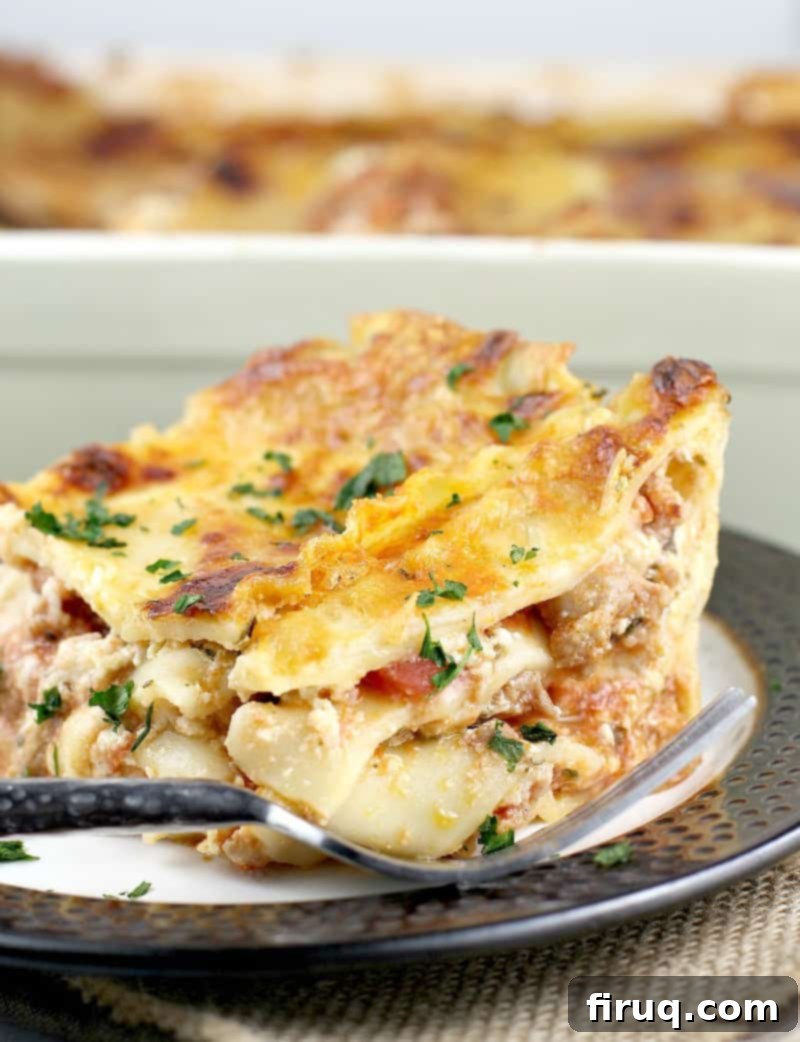
However, despite its seemingly straightforward nature, preparing a truly exceptional lasagna can be surprisingly challenging. This dish, which admittedly requires a bit of effort and love, is one you definitely don’t want to mess up. Over the years, we’ve identified common pitfalls that can derail even the most enthusiastic home cooks. Let’s delve into what to avoid to ensure your culinary efforts are rewarded with pure perfection.
Common Missteps: Ways to Ruin a Good Lasagna
To ensure your classic lasagna turns out gloriously, it’s crucial to sidestep these common pitfalls. Awareness of these mistakes is the first step toward creating a truly perfect lasagna:
- Soupy Lasagna from Excess Sauce: One of the most frequent complaints is a lasagna that’s too watery or soupy. This often happens from using an excessive amount of marinara sauce, or a marinara that is too thin. The pasta needs liquid to absorb and soften, but too much will prevent the dish from setting properly, leading to a runny, unappealing texture.
- Dry, Cakey Ricotta: If you use plain ricotta cheese straight from the container without any modifications, it can become dense, crumbly, and unpleasantly dry during baking. This creates distinct, dry pockets in your otherwise moist lasagna. The key is to blend it with an egg or béchamel (or both, as in our recipe) to create a smooth, creamy, and spreadable layer that integrates beautifully with the other ingredients.
- Overcooked, Mushy Noodles: Boiling your lasagna noodles for too long results in a mushy, soft texture that lacks the necessary bite and structure. Lasagna noodles continue to cook and absorb liquid in the oven, so cooking them just to an al dente stage is vital. They should still have a slight firmness, ready to absorb the rich sauces during baking.
- Chewy No-Bake Noodles: While convenient, no-bake (or oven-ready) noodles require extra moisture to cook properly. If you don’t adjust your sauce quantities accordingly, these noodles can end up partially cooked, chewy, and tough, leaving a disappointing texture in your final dish. Stick to traditional noodles for best results, or ensure ample sauce if using no-bake.
- Sacrificing Flavor with Jarred Spaghetti Sauce: Using pre-made, jarred spaghetti sauce, while quick, often lacks the depth, freshness, and nuanced flavor that homemade marinara provides. The sauce is the backbone of your lasagna, and a bland or overly sweet store-bought sauce can undermine the entire dish, preventing it from reaching its full potential.
- Skipping the Base Sauce Layer: Failing to spread a thin layer of sauce at the bottom of your baking pan before adding the first layer of noodles is a common oversight. This initial sauce layer is crucial for preventing the noodles from sticking to the pan and burning, and it also helps them cook evenly and tenderly.
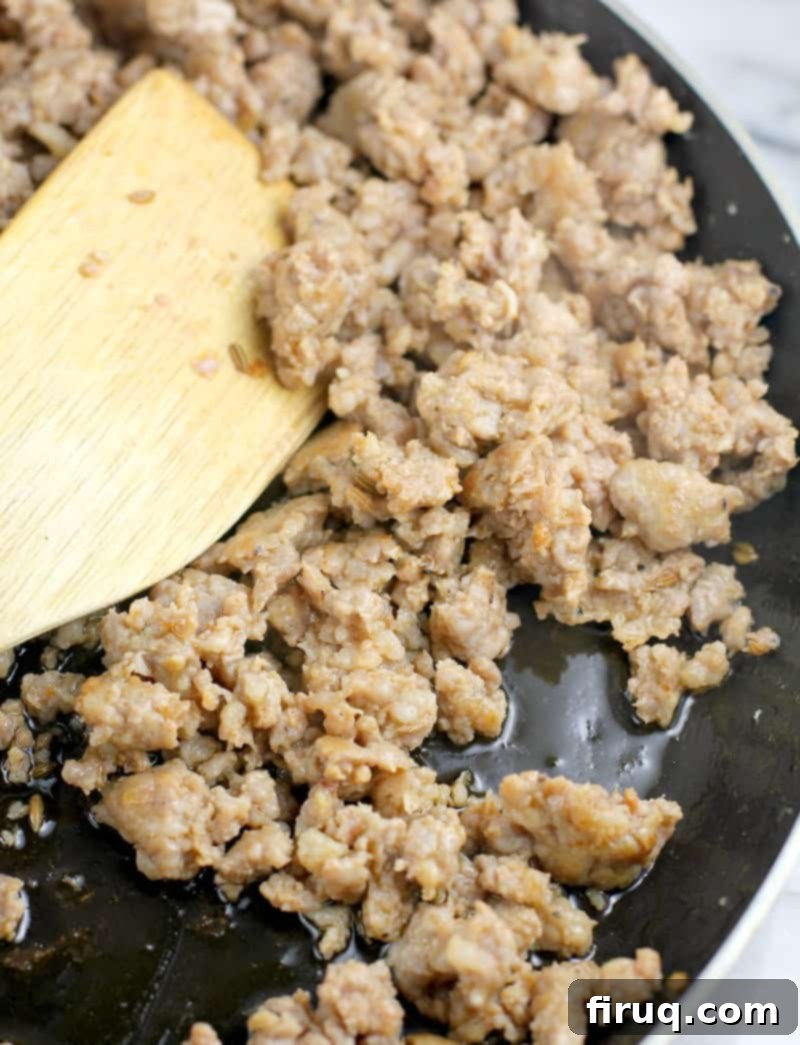
Insider Tips for Crafting the Perfect Lasagna
Achieving a truly scrumptious, luxurious, and amazingly good classic lasagna isn’t just about following a recipe; it’s about understanding the subtle nuances and techniques that elevate it from good to unforgettable. These are the tricks and adjustments we’ve refined over the years, ensuring every bite of your homemade lasagna is pure perfection:
Use regular lasagna noodles and cook them just al dente. This is a non-negotiable step for optimal texture. Lasagna noodles are designed to continue cooking and absorbing moisture in the oven. If you overcook them initially, they will become mushy and lose their structural integrity, resulting in a soft, unappealing dish. By cooking them only until they are al dente – meaning they still have a slight bite and firmness – you ensure they reach the perfect tender-chewy consistency once the lasagna is fully baked. This also allows them to provide the necessary structure, holding the layers together beautifully.
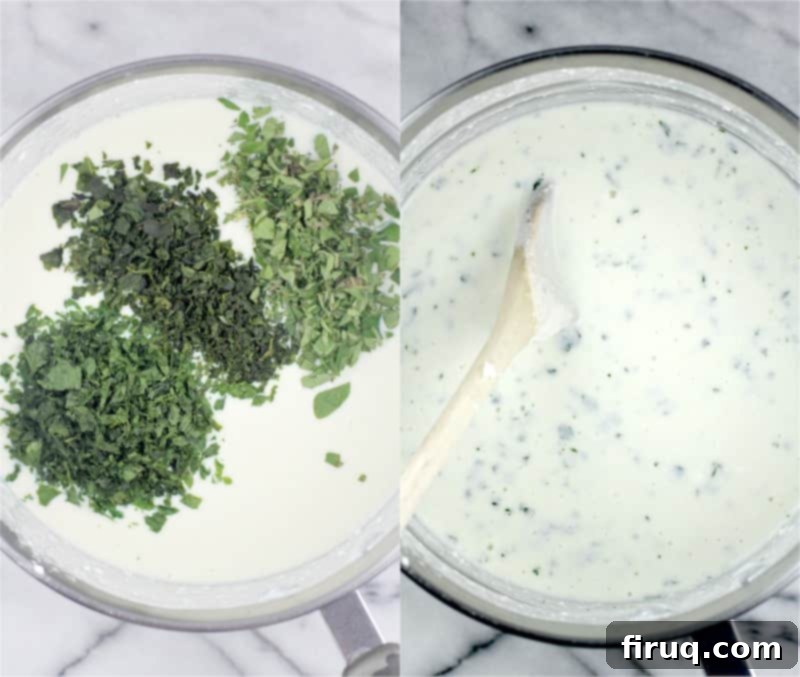
Transform plain ricotta into a white “sauce” with béchamel and egg. This is perhaps the most critical tip for an exceptionally creamy and flavorful lasagna. Instead of simply spooning plain ricotta, which can become dry and crumbly, we create a rich, smooth ricotta-herb sauce. This involves first making a basic béchamel – a classic French white sauce made from butter, flour, and milk – then blending it with ricotta cheese, a lightly beaten egg, salt, and fresh herbs. The béchamel adds an incredible creaminess and richness, while the egg binds the mixture and prevents the ricotta from drying out. This luxurious sauce melds seamlessly with the meat and marinara layers, delivering perfect flavor and a consistent, moist texture throughout, ensuring no dry mouthfuls of ricotta.
Let us stress the importance of this ricotta-herb sauce. We tinkered with classic lasagna recipes for years, experiencing the common frustrations of dry ricotta or inconsistent textures, before discovering that this specific sauce was the game-changer. It’s the secret weapon that elevates this recipe to the realm of the best lasagna you will ever make.
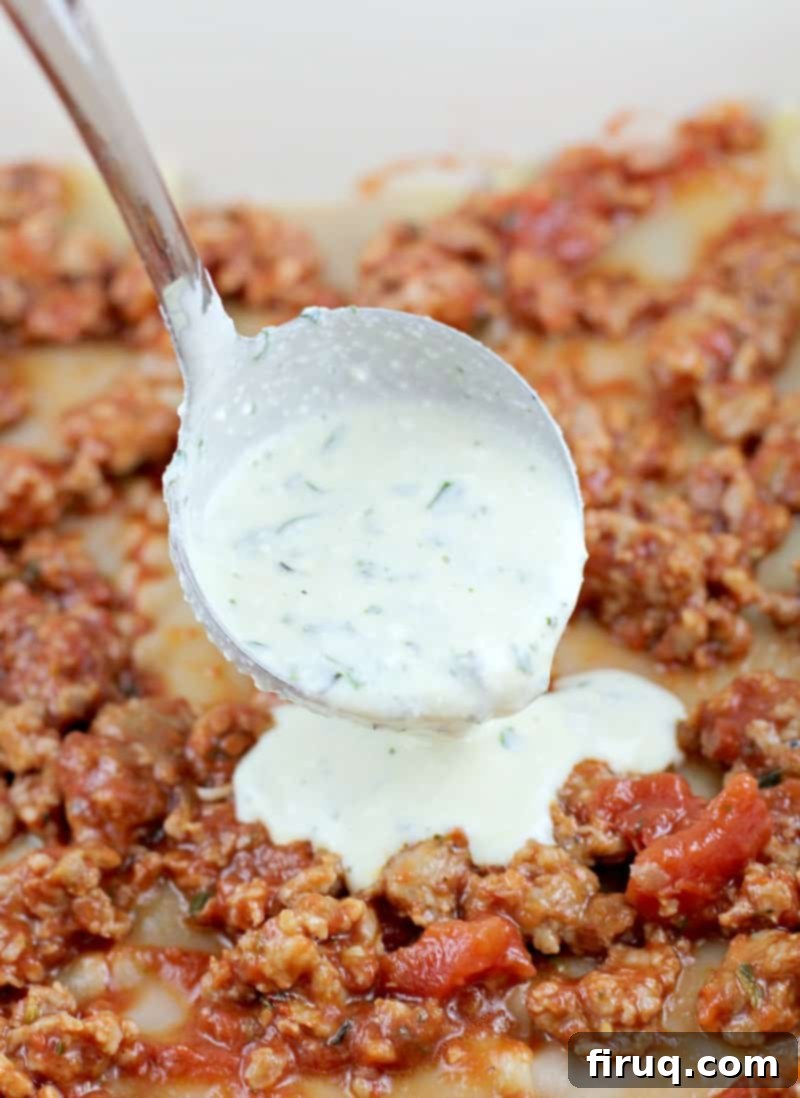
Incorporate an abundance of fresh herbs! Fresh herbs are not merely a garnish; they are integral to the vibrant flavor profile of this traditional lasagna recipe. Using generous amounts of freshly chopped oregano, Italian flat-leaf parsley, and basil introduces a brightness and aromatic complexity that dried herbs simply cannot replicate. These herbs infuse the ricotta sauce with their distinct, fragrant notes, providing a beautiful contrast to the richness of the meat and cheese. Their lovely color also adds to the visual appeal, making each slice of lasagna even more enticing.
Commit to making our own homemade marinara. While convenience is tempting, the difference a homemade marinara sauce makes is truly astounding. Our marinara recipe is simple to make and yields an incredibly deep, complex flavor that is far superior to any store-bought alternative. This rich, slow-simmered sauce forms the flavorful foundation of the lasagna. When combined with the creamy ricotta-herb sauce, it creates a harmonious balance of sweet, savory, and aromatic notes that defines the very essence of a perfect lasagna. It’s a small investment of time that pays off immensely in taste.
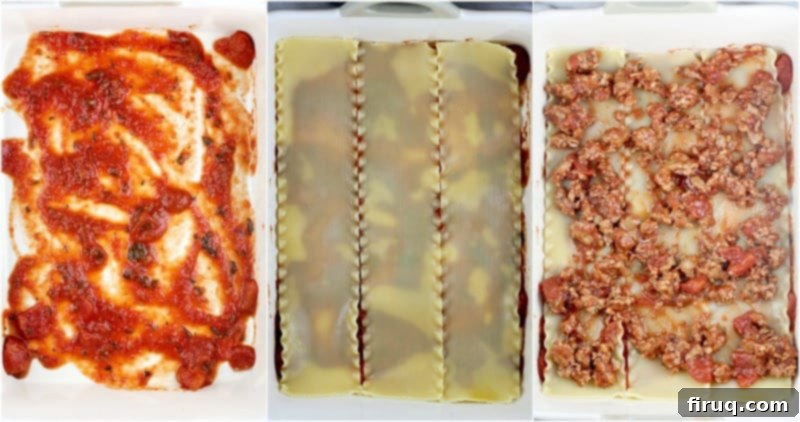
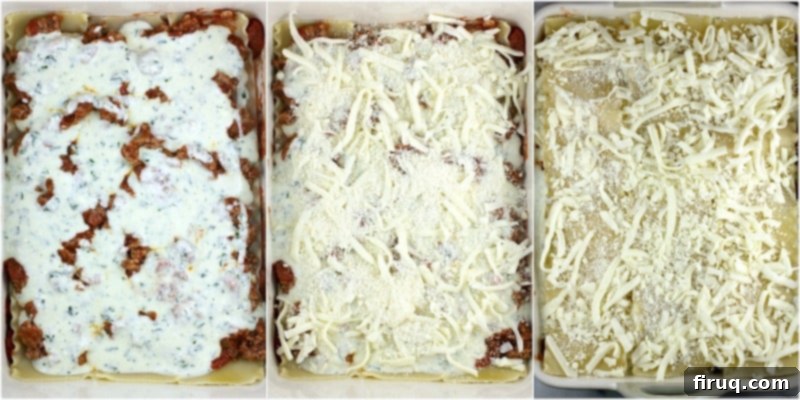
Bake uncovered initially, then tent with foil if the top browns too quickly. For that desirable golden-brown top and slightly crispy edges, begin baking your lasagna uncovered. This allows the cheese to melt beautifully and achieve a delicious crust. Keep a close eye on it, and if the top starts to darken too much before the center is bubbly and fully cooked, simply tent a piece of aluminum foil loosely over the pan. This protects the top from burning while allowing the internal layers to finish cooking evenly. Those bits of crunch and texture around the edges are a signature characteristic of a well-baked classic lasagna.
Invest in a proper lasagna pan. While a standard 13×9 inch baking dish will work, a dedicated lasagna pan often offers slightly deeper sides, providing more room for layers and reducing the risk of overflow. Deeper pans help contain all the delicious lasagna ingredients and their bubbling sauces, preventing them from simmering over in the oven and making a mess. This ensures all the flavor stays where it belongs: within your magnificent creation.
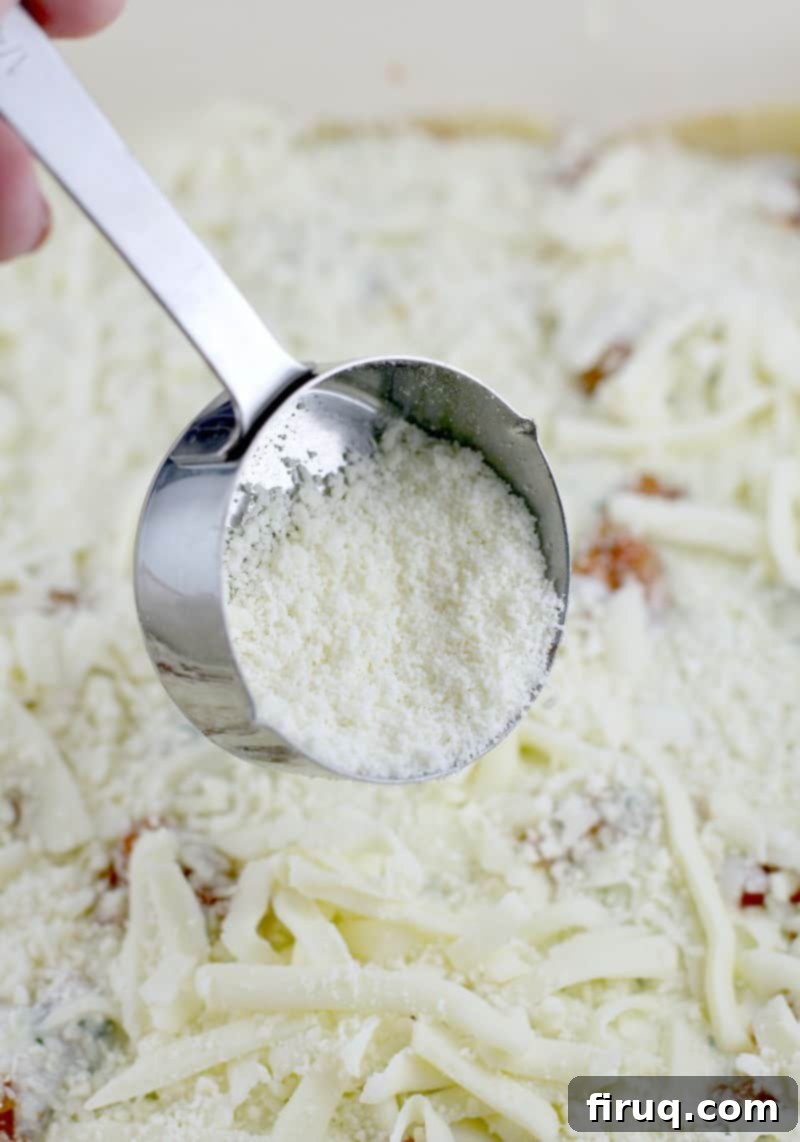
Always use freshly grated Parmigiano-Reggiano cheese. The quality of your cheese makes a significant difference. While it’s convenient that many grocery stores now offer freshly grated Parmesan in their dairy or deli sections (which is perfectly acceptable and what we used for the lasagna in these photos), steer clear of the pre-grated varieties found in the pasta aisle. These often contain cellulose powder and anti-caking agents that prevent them from melting properly. Instead of contributing to a smooth, flavorful cheese layer, they can remain grainy and create an undesirable texture. For your perfectly perfect lasagna, opt for real, fresh Parmigiano-Reggiano – its sharp, nutty flavor and superior melt are indispensable.
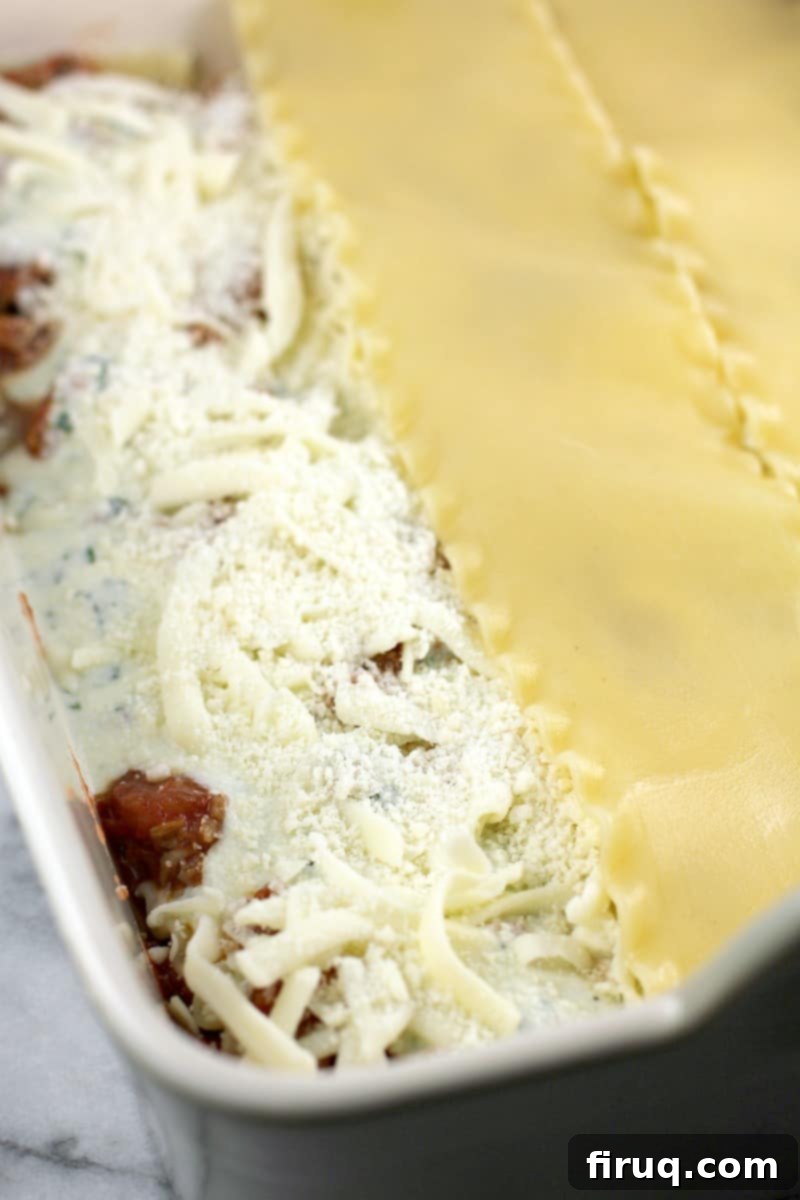
How to Assemble Your Classic Lasagna: A Step-by-Step Guide
Bringing all these incredible lasagna ingredients together to form this amazing dish is a satisfying process. Here’s a simplified breakdown of how to construct your culinary masterpiece:
- Prepare the Meat Sauce: Start by browning your mild Italian sausage. Once cooked and drained of excess fat, combine it with a generous portion of our delicious homemade marinara sauce. This creates a rich, savory foundation for your lasagna.
- Craft the Ricotta-Herb Sauce: Begin by making a smooth béchamel sauce. Then, whisk in the creamy ricotta cheese, a lightly beaten egg, kosher salt, and your vibrant fresh herbs (oregano, parsley, and basil). This mixture will be wonderfully smooth and aromatic.
- Cook the Noodles: Boil your lasagna noodles to a perfect al dente stage according to package directions. Immediately drain them and give them a quick rinse with cold water. This stops the cooking process and makes them much easier to handle without sticking.
- Assemble the Lasagna Layers: This is where the magic happens! Start by spreading a thin “wee bit” of marinara sauce on the bottom of your lasagna pan to prevent sticking. Then, lay down your first layer of cooked noodles, followed by a generous portion of the rich meat sauce, then a decadent layer of the béchamel-ricotta sauce, and finally, a sprinkle of both Parmigiano-Reggiano and shredded mozzarella cheeses. Repeat these layers two more times, finishing with a final layer of pasta crowned with the remaining cheeses.
- Bake to Golden Perfection: Place your assembled lasagna in a preheated oven and bake until it’s bubbly, golden brown, and cooked through. Remember to tent with foil if the top starts to brown too quickly. Allow it to rest for at least 10-15 minutes before slicing – this is crucial for the layers to set and prevent it from falling apart when served.
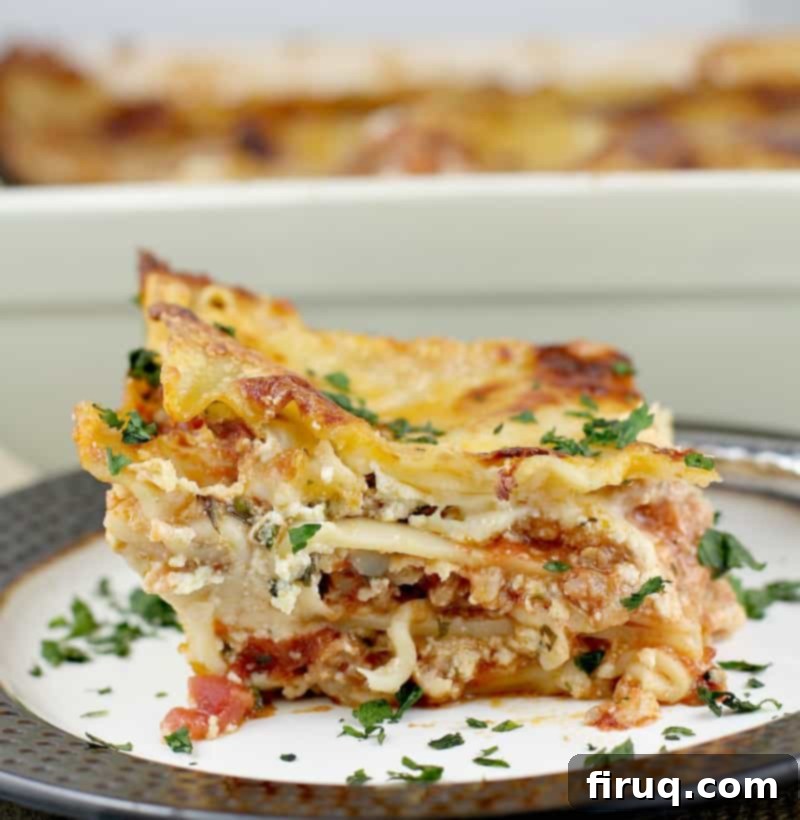
And here’s a little secret, common to all traditional lasagna recipes and a testament to truly good food: this classic lasagna, with all its married ingredients, often tastes even better reheated the next day. The flavors have more time to meld and deepen, making leftovers a highly anticipated treat.
We invite you to enjoy this recipe, which stands as one of our proudest, most favorite, and undeniably delicious creations. So much love, experimentation, and time have been poured into perfecting this dish, and that part of the process is truly what we cherish. Some recipes come together more easily than others, and some require more dedication, but the journey of perfecting this classic lasagna was absolutely worth it. We are confident that it will become a cherished staple in your home.
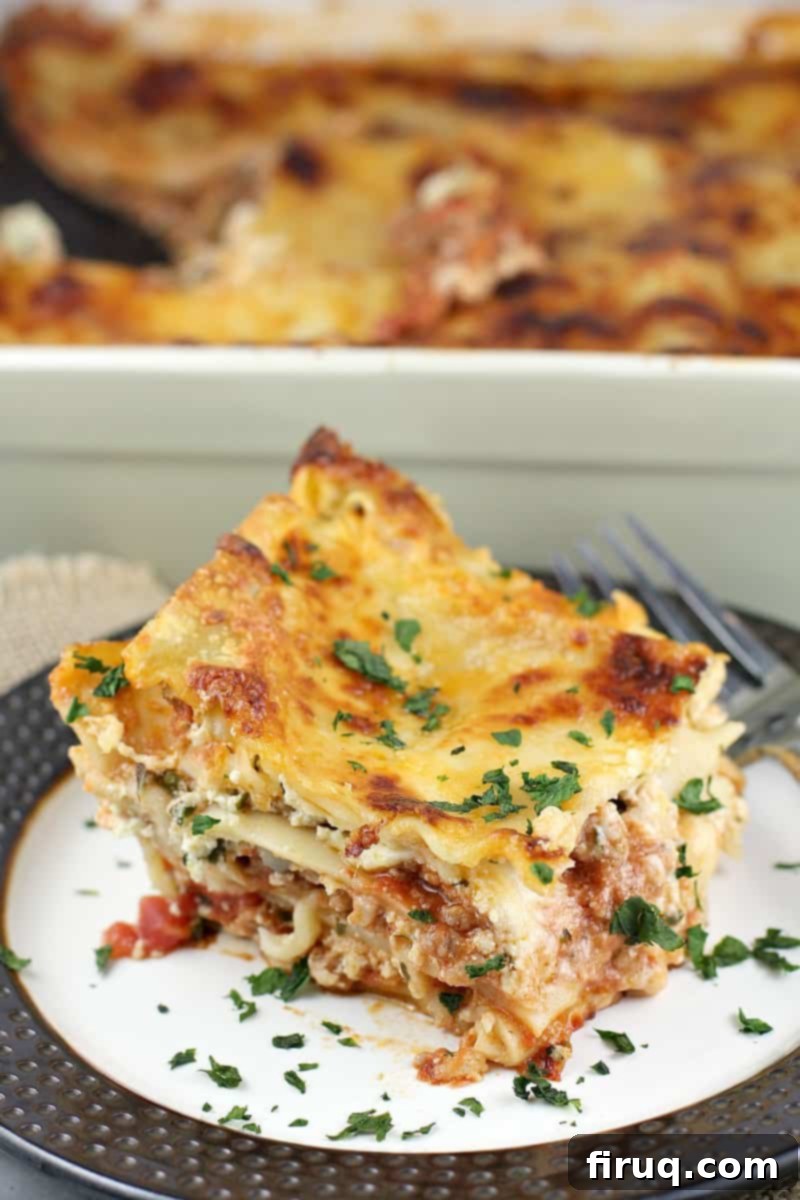
Explore More Comforting Casserole Recipes
If you’ve fallen in love with the comforting embrace of a classic lasagna, you’ll be thrilled to discover our other go-to casserole recipes. These dishes are perfect for family dinners, entertaining guests, or simply enjoying a hearty meal on a cozy evening. Each one promises warmth, flavor, and that satisfying feeling only a well-made casserole can provide:
- Fresh Salmon Casserole – This recipe is SO GOOD. Using fresh salmon takes this from ho-hum to fantastic, creating an elegant yet comforting meal.
- Cornbread Pork Chop Casserole – An easy weeknight dinner that delivers unbelievably succulent chops, baked under a delicious cornbread topping.
- Broccoli Cheese Casserole – Literally one of our favorite casseroles to make for crowds. It’s incredibly easy to scale this up to feed 100 people without sacrificing flavor.
- Slow Cooker Quinoa Tamale Casserole – A unique, dairy-free, and gluten-free dinner that becomes even more amazing when finished with a sunny, runny egg.
- Jalapeno Popper Hash Brown Casserole – Because hash brown casseroles rock, and adding the kick of jalapeno poppers takes it to an exciting new level.
- Cheesy Chicken Casserole – A delightful throwback classic, reimagined and served beautifully in crispy filo shells for an elegant touch.
- Green Bean Casserole – Elevate the old classic recipe with fresh mushrooms and a generous amount of cheese for a truly delicious new take.
- Tuna Noodle Casserole – The ultimate old standby, a comforting dish that has stood the test of time and graced tables in every era of our lives.
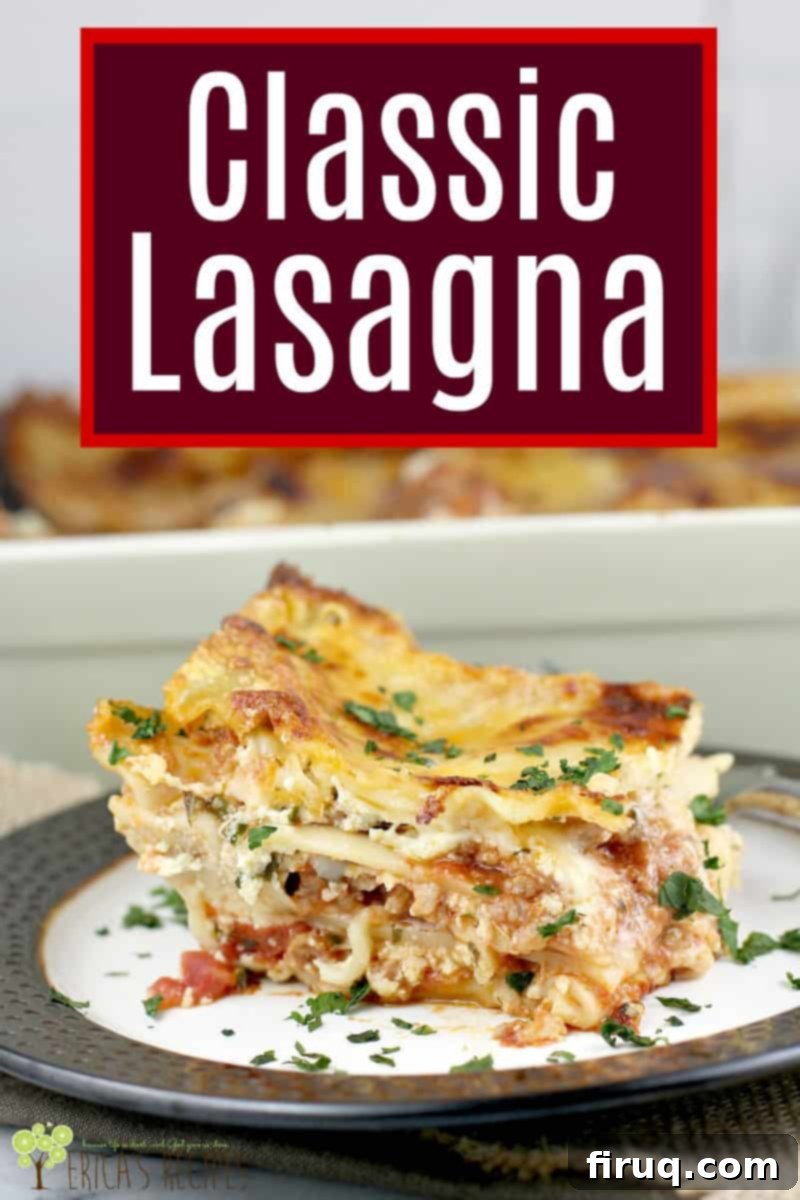
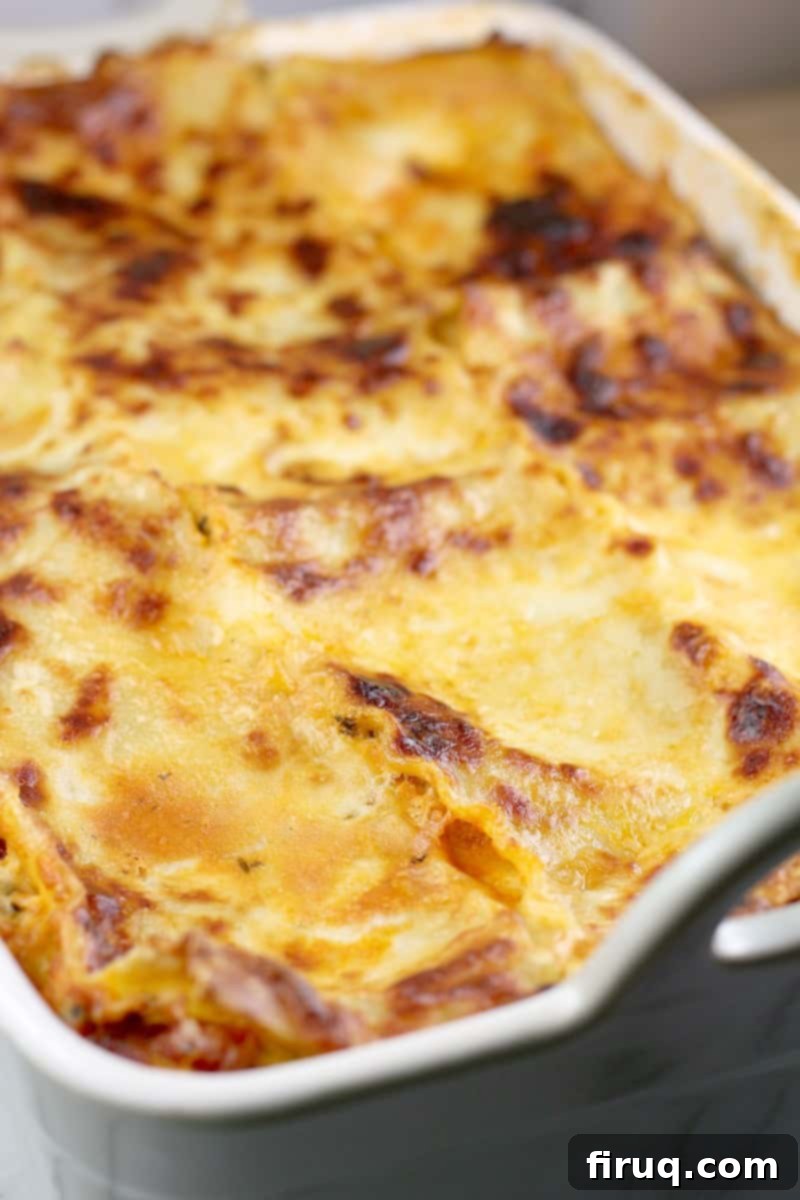
Classic Lasagna
Print
Pin
Rate
Equipment
-
lasagna pan
Ingredients
For the Béchamel-Ricotta Sauce
- 2 Tbsp unsalted butter
- 2 Tbsp all-purpose flour
- 2 cups milk
- 1 (15 oz) container ricotta cheese
- 2 tsp kosher salt
- 1 Tbsp fresh oregano leaves chopped
- 2 Tbsp fresh Italian flat-leaf parsley chopped
- 1 Tbsp fresh basil leaves chopped
- 1 large egg lightly beaten
For the Lasagna
- 12 lasagna noodles
- 2 ½ cups Homemade Marinara Sauce divided
- 1 ½ lb mild Italian sausage casings removed, cooked, crumbled, and drained of fat
- 1 cup freshly grated Parmigiano-Reggiano cheese
- 4 cups shredded mozzarella cheese
Instructions
For the Béchamel-Ricotta Sauce
-
In a medium saucepan, heat the butter until melted. Add the flour and whisk until smooth. Over medium heat, cook the roux 2-3 minutes. Slowly add the milk, whisking constantly.
-
Cook ~5 minutes, stirring constantly, until thickened enough to coat the back of a spoon. Remove from the heat and set aside to cool a bit while you cook the pasta.
-
Once ready to assemble the lasagna, whisk in ricotta, salt, egg, and herbs into the béchamel.
For the Lasagna
-
Heat oven to 350F.
-
Add 2 cups marinara sauce to the cooked sausage make a meat sauce. Set aside.
-
Bring a large pot of water to a boil.
-
Cook the noodles to al dente according to package directions. Drain and rinse briefly with cold water.
-
Spread the remaining 1/2 cup marinara sauce in a lasagna dish. Layer 3 noodles, 1/3 of the meat sauce, 1/3 of the béchamel-ricotta sauce, and 1/4 of each cheese. Repeat twice. Finish with a final layer of pasta and the last 1/4 of each cheese.
-
Bake uncovered at 350F until bubbly, about an hour. Tent with foil over top if the top starts to get too brown. Let stand 10 min before cutting.
Notes
Nutrition
~✿♥✿~
